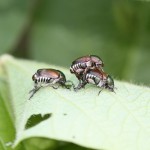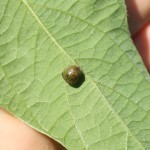These two invasive species look like they will be present in most areas of the state from this point forward. The news is not all bad because, in field crops, they pose either a minor or manageable risk. However, both pests require timely scouting and decision making.
 Japanese beetles are beginning to show up in numbers. Fortunately, they seldom cause economic injury to field crops. The greatest threat is defoliation caused in soybean. Treatment in recommended when 35% or more defoliation occurs prior to bloom or when 20-25% defoliation occurs from R1 to R6. My experience suggests that 1 beetle per sweep may cause this level of injury, but this depends on the size of the beans and how long the beetles persist. In corn, the only real concern is silk feeding. We’ve done research on this. The suggested threshold is 3 or more beetles per ear during the first week of silking. It is very unusual to see this level of infestation, except perhaps on field edges. Our data suggest there is more chance of yield loss when plants are under significant drought stress.
Japanese beetles are beginning to show up in numbers. Fortunately, they seldom cause economic injury to field crops. The greatest threat is defoliation caused in soybean. Treatment in recommended when 35% or more defoliation occurs prior to bloom or when 20-25% defoliation occurs from R1 to R6. My experience suggests that 1 beetle per sweep may cause this level of injury, but this depends on the size of the beans and how long the beetles persist. In corn, the only real concern is silk feeding. We’ve done research on this. The suggested threshold is 3 or more beetles per ear during the first week of silking. It is very unusual to see this level of infestation, except perhaps on field edges. Our data suggest there is more chance of yield loss when plants are under significant drought stress.
 Kudzu bugs are a newer pest that will primarily affect soybean and some other legume food crops. Based on my initial observations this year, it appears we had some winter kill. However, I expect this species to continue its march across the South. Populations now, except in more eastern areas of the state, are occurring almost exclusively on kudzu. It will be the next generation that occurs in late summer that will cause the most problems. Kudzu bugs can occur in large numbers, but fortunately, it take more than a few to cause yield loss. I recently prepared a fact sheet on this pest (link here). One immature kudzu bug per sweep is the most used threshold for this pest.
Kudzu bugs are a newer pest that will primarily affect soybean and some other legume food crops. Based on my initial observations this year, it appears we had some winter kill. However, I expect this species to continue its march across the South. Populations now, except in more eastern areas of the state, are occurring almost exclusively on kudzu. It will be the next generation that occurs in late summer that will cause the most problems. Kudzu bugs can occur in large numbers, but fortunately, it take more than a few to cause yield loss. I recently prepared a fact sheet on this pest (link here). One immature kudzu bug per sweep is the most used threshold for this pest.
Insecticide wise, bifenthrin or other pyrethroid insecticides are typically used to control either pest. Details of treatment thresholds and suggested insecticides and rates are listed in UT’s Insect Control Recommendations for Field Crops.

